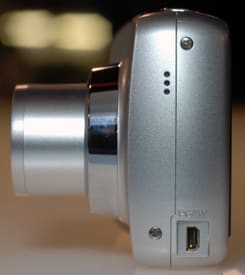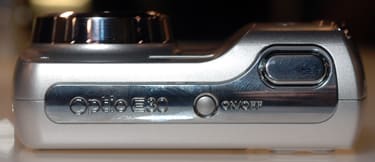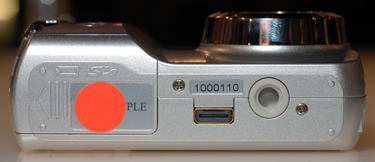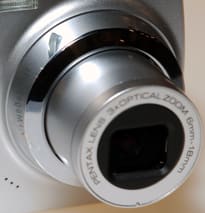Performance Expectations
Testing/Performance Expectations **
Because we evaluated the E30 at a trade show, rather than in our own lab, we don't have anything specific to say about its imaging performance – we simply can't do reliable, quantifiable testing without the controlled conditions we maintain in our test suite at home. Compounding the issue, Pentax representatives say the unit we handled does not have finalized firmware, which can have a significant effect on camera performance.
That said, our test shots looked very sharp when magnified on the E30's LCD screen. We looked for color fringing in our images and didn't see it on the LCD. We noticed some barrel distortion at the wide-angle end of the zoom range. When we test a production version, we'll be able to verify these impressions.
Physical Tour
**Front
**Pentax says the E30 is made of plastic polymer, and we imagine that is one way Pentax kept costs down. On most cameras, there are at least a couple of metal components – the wrist strap lug, for instance. The E30 seems to be plastic, except for some trim on the lens assembly. The left side of the front is a wide, flat grip, with a curved ridge where the user's fingers will rest. The lens mount is a large, thick cylinder. When the E30 is on, a smaller, narrower and lighter cylinder telescopes out, bringing the lens into position. The flash is small, slot-shaped and to the left of the lens, near the top edge of the camera. A small round window on the upper right is an autofocus assist light and probably a self-timer indicator. Three small holes between the lens mount and the grip indicate the microphone.

**Back
**The 2.4-inch, 110,000-pixel LCD takes up much of the back of the Optio E30, but, with relatively few controls, the back doesn't feel crowded. A rocker switch at upper right controls the zoom in shooting mode and magnification in playback. The playback button is lower, and near the right edge of the LCD. The 4-way controller is a collection of five buttons. Four of them are arc-shaped and surround the circular OK button. When they aren't being used for navigation, the top button activates the self-timer and burst mode, the right button controls focus mode, the bottom one activates the mode control, and the left one sets the flash mode. Along the bottom edge are the Menu and Easy buttons. The green Easy button puts the E30 in its most automated, simple shooting mode.
There's a ridge along the right edge of the back, which functions as a thumb rest, sort of.
**Left Side
**The Pentax E30's USB/AV jack is low on the left side and has no door or cover – it's just always open, ready to fill up with dirt, moisture and crud. Three holes higher up on the side form the speaker grill.

Right Side
The wrist strap lug is molded of the same plastic as the E30's body. It sits flush against the body of the camera and looks sturdy enough, though we expect it will be a chore to thread a strap through it. The right side also has a small rubber tab at the bottom, apparently to allow the external power cord access to the battery contacts.

**Top
**A shiny plate on the top of the E30 reads "Optio E30." The power button is sunken into the plate. It's a small button, and it appears to be designed so that the E30 won't accidentally power up inside a bag or pocket. We find rotating switches better on that score, and the E30's button a little tough to operate even on purpose. The shutter release button is on top of the grip. It's large and has a smooth, positive action.

**Bottom **
The tripod bushing is centered under the lens, which is good – it can make aiming the camera on a tripod easier. Unfortunately, it's plastic and may not hold up well against metal tripod studs. The E30 has a port for standard printer docks as well. The battery and SD card compartment door is plastic and slides closed with a snap. Unfortunately, there is no provision to hold the two AA batteries in place while changing the memory card, so there's a likelihood that the batteries will fall out or get in the way in that process.

Components
**Viewfinder
**Like most compacts, the E30 has no optical viewfinder. It relies instead on the LCD's live view.
**LCD Screen
**The Optio E30 has a 2.4-inch, 110,000-pixel LCD. Most cameras have higher pixel count than that, and we guess that Pentax choose this component to keep its costs down. The field of view is narrow and we found the contrast low, which might be a firmware issue. The display is remarkably sharp, though. It seemed good enough to check image sharpness critically. We were less confident of its color performance, but again, the conditions in the vibrant and exciting Las Vegas Convention Center limited our ability to make a definitive judgment.

**Flash
**The Optio E30's flash is tiny and slot-shaped. We did not have the opportunity to test it. Pentax says it's good to 14.4 feet at wide angle and 9 feet at telephoto, with the camera set to auto. It's close to the lens, so it's likely to produce redeye. Because it's off-center from the lens, it will cast shadows sideways, which can lead to unattractive results. The small size is a problem, too: Small light sources make very harsh shadows, a phenomenon that can accentuate skin blemishes.
The E30's flash can be set to always on, automatic (the E30 decides when to flash), off, on with a redeye reduction preflash and auto with redeye reduction.
**Zoom Lens
**The Pentax 6-18mm zoom lens is comparable to a 38-108mm lens on a 35mm camera. It runs from a very mild wide angle to a mild telephoto. Its maximum aperture runs from f/2.7 to 4.8. It's a typical lens for an entry-level camera. We expect that some users will be limited by the dark maximum aperture at the telephoto setting, but more-capable lenses aren't available on cameras as inexpensive as this one.

Design/Layout
**Model Design / Appearance
**The inexpensiveness comes through on the Optio E30. It's plain, but not elegant. Its simplicity stems from its lack of features, not of cunning design. The Pentax Optio line includes some attractive cameras, but the E30 is almost Kodak-like in its clunky look.
**Size / Portability
**Measuring 3.7 x 2.4 x 1.4 inches and 6.5 ounces ready to shoot, the E30 will fit in plenty of coat pockets, purses and backpacks. Its size is appealing, but it is not sealed against dust, dirt and moisture, so carrying it loose is a bad idea. Its lens mechanism will get gummed up, or its electronics will get flaky.
**Handling Ability
**The Optio E30 is comfortable to hold in the user's right hand. Though it doesn't have textured grips, it felt secure. All compact cameras perform better if users hold them with two hands. Unfortunately, the E30 doesn't really encourage a two-handed grip through design. The best option is to hold it with the left thumb supporting the bottom and the left index finger on top, but there are no divots or grips that indicate that.

**Control Button / Dial Positioning / Size
**The Optio E30's buttons are large enough, and well-spaced. We didn't have trouble operating them, or accidentally hitting the wrong one because it was too close to the one we wanted. The shutter release is large and has a good feel. The power button is too small, in a wrong-headed attempt to prevent the camera from being accidentally turned on. The zoom control is also difficult, overshooting the amount of adjustment we intended to make.
**Menu
**The Pentax E30 maintains the sensible and clear menu structure of the Optio line. Many items are superimposed over a live preview. The text is clear, and the entries are subdivided logically.
The Playback menus are accessed by hitting the Mode button, then the playback icon onscreen
**Ease of Use
**The Optio E30 is very easy to use in its fully automatic modes. Features that allow a bit of user discretion are not easy to access, however. Exposure compensation is a menu item, for instance. One of the 4-way controller buttons should bring it up directly. The live previews are very good, reflecting changes in the white balance setting or exposure compensation. The E30 lacks a histogram, a feature that even casual snapshooters should use. Again, the zoom control has a backlash problem, and changing the SD card risks having the batteries fall out.
Modes
**Auto Mode
**Pentax Optio cameras typically have a full auto mode that's activated with a big green button. The E30 has it. In the simple mode, the E30 takes over exposure, white balance, focus and every other parameter.
The E30 also offers a Program mode, which selects exposure, but allows the user to set other parameters.
**Movie Mode
**The E30 has a movie mode with resolutions of 640 x 480 and 320 x 240. Pentax specs list frame rates of 28 fps for 640 and 30 fps for 320. Because the E30 only has one microphone and speaker, it's a good bet that the sound is monaural. The length of movies is limited only by memory and battery capacity. We couldn't review image quality, but noted that the zoom feature became jerky in movie mode. It appeared that the E30 does not alter focus while a clip is being shot, so those near-far pans that grace so many movies can't be shot with it.
**Drive / Burst Mode
**The E30 has a burst mode, but Pentax doesn't list a frame rate or number of shots for it. We couldn't test frame rate in the sterile but chaotic confines of the Las Vegas Convention Center, but we got bursts of 3 images at a time at the largest image size and best quality. We don't know if that was limited by the supplied SD card, the shutter speed achievable in the dim conditions under which we shot or by other factors.
**Playback Mode
**The Optio E30 can show up to 9 thumbnail images at a time and can zoom in to 8x magnification, which is good enough to judge image sharpness. The E30 lacks a histogram, but in Playback, it shows shooting information including f-stop and shutter speed, two parameters we couldn't get to display during shooting. It also shows ISO, quality, white balance, file number, date and time.
The E30 can crop or downsize images in Playback, as well as access PictBridge printers.
The Playback mode also features a slide show function with a choice of transitions and intervals. The E30 shows all the images in memory – the user can't select just a group for display. Custom Image PresetsThe Optio E30 offers a range of preset modes. Most simply set the camera for specific types of shooting, but others go beyond. There is a text help system, but it's vague and does not include example images.** **
Control Options
**Manual Control Options
**The Pentax E30 does not offer manual exposure control, but it allows exposure compensation, manual ISO, manual focus and manual white balance.
**Focus
***Auto Focus
*The Optio E30 focused well when we examined it at CES. We couldn't test it in truly low light, but the lighting in the cavernous yet intimate Las Vegas Convention Center was far from ideal. It appears to have three sensors in a row across the middle of the frame, but it can be set to spot focus on the center. The user can freeze focus by keeping the shutter release pressed halfway.
*Manual Focus
*It was a little surprising to find manual focus on a camera as pared-down as the Optio E30. Still more surprising was its good performance.
The user controls focus with the 4-way controller and can monitor a distance scale superimposed on the live view. A highly magnified portion of the image fills the screen and image noise is controlled well enough that focus is pretty obvious. It snaps into focus. Having the image enlarged prevents the user from seeing exactly how the picture is framed.
The E30 also offers an infinity lock which is useful for night landscapes and fireworks.
**Exposure
**The Optio E30 does not have any manual exposure modes or even partially manual ones. It offers exposure compensation, but that's accessed through the menu system, so tweaking exposure is a pretty clunky process.
**Metering
**The Optio E30 offers only multisegment metering. The camera takes several separate readings across the frame and uses an algorithm to determine the best exposure by comparing the various readings. Such systems are supposed to be able to identify backlighting and other tricky situations, but we could not test how successful the E30 system is. Check our full review for more information.
**White Balance
**In addtion to automatic white balance, the Optio E30 offers presets for daylight, shade, tungsten and fluorescent light. We couldn't test the presets in the pallid yet luxurious lighting of the Las Vegas Convention Center. The E30 also has a custom white balance feature. We couldn't evaluate it either, but custom settings often give good results when the other options can't. The user creates a custom setting through the white balance menu, by pointing the camera at something white and pressing the OK button.
**ISO
**The Optio E30 has an automatic option for ISO, and it allows the user to set sensitivity to 80, 160, 320 or 400. Many compact cameras offer higher ISO settings that 400, usually with a significant penalty in image quality. The E30's ISO is set via a menu, so the process is a little slow. Depending on the display setting, the user can see the ISO onscreen while shooting or in playback.
**Shutter Speed
**The Pentax spec sheet says the E30 has a shutter speed range of approximately 1/2000 to 4 seconds. The range is ample for the needs of the typical user. There is no way to manually set or monitor shutter speed on the E30.
**Aperture
**The maximum aperture for the E30's zoom ranges from f/2.7 to 4.8. The f/4.8 setting will limit available-light shooting, but the E30's aperture range is comparable to other cameras in its class. We don't have any data about the minimum aperture available on the E30, because it can't be set manually. Typically, such short focal-length lenses don't perform well below f/8.
Image Parameters
**Picture Quality / Size Options
**The Optio E30 offers image pixel dimensions of 7, 5, 4, 3, 0.7 Megapixels, and VGA. The E30 records only JPEGS, but it offers three levels of compression, indicated by 1, 2 or 3 stars. The smallest sizes are appropriate for email and onscreen display.
**Picture Effects Mode
**The Optio E30 doesn't offer specific effects, but it has controls for contrast, saturation and sharpness. Each control can be set to high, low or medium.
Connectivity/Extras
**Connectivity
***

Software
*Pentax hasn't determined yet what software will ship with the Optio E30.
*Jacks, Ports, Plugs
*The Optio E30 has a USB/AV jack for connection to a printer, computer or analog video display. It also has a standard Image Link dock port, to fit a range of printers. The E30 can also accept an optional DC power source.
*Direct Print Options
*The Optio E30 is compliant with PictBridge direct printing DPOF print ordering, and Image Link printers. The E30 user can specify the number of prints and can crop images. PictBridge and DPOF have a range of other features. In a full review, we'll explore whether the Pentax E30 offers those as well.
*Battery
*The Optio E30 accepts 2 standard AA batteries. Pentax claims the E30 can shoot 200 shots with a pair of good alkalines, and up to 550 with high-capacity NiMH rechargables. We did not get a sense of the E30's power consumption as we examined it, but Pentax's figures suggest that it's frugal with the mili-amps.
*Memory
*The Optio E30 has 11 MB of memory built in, and it accepts SD cards. The internal memory will hold several favorite images so the camera can double as a brag book, but it's necessary to get an SD card to use the camera in any practical way. SD cards are the most common format for camera memory. They are available in a wide range of capacities, and are relatively inexpensive.
**Other Features **
Choice of Cat or Dog icon for pet mode – As dog owners, we're delighted that we wouldn't have to have a cat icon onscreen when we snap shots of Sparky.
Icon-based scene mode selection – The graphical interface for scene modes is perky and somehow fitting for the casual, simple nature of the E30.
Quick Zoom – Allows users to check focus quickly in playback by zooming to maximum magnification immediately.
Overall Impressions
**
Value
**For about $150, it's hard to say that a 7-megapixel camera isn't at least a pretty good value. The E30 delivers basic functions at a low price. We'd like a better look at its image quality before we call it a bargain, but the E30 has the interface and construction of cameras that cost closer to $200.
**Who’s this Camera For?
***Point-and-shooters –* The Optio E30 is a very simple camera. Users who want to avoid complexity and choices should consider it.
Budget Consumer – At $149.95, or probably less, the E30 is competitive with closeouts and re-manufactured cameras. Pentax is going for the price-sensitive consumer with this one.
*Gadget Freaks – *There is nothing cutting-edge or cool about the E30. Gadgeteers in the know will avoid this one.
Manual Control Freaks – The E30 lacks every quality that a manual control shooter wants.
Pros/Serious Amateurs – The E30 doesn't have the options that the market segment looks for.
Conclusion
**Conclusion
**The Pentax Optio E30 is a very inexpensive, very simple camera. The appropriate market for it is the price-conscious non-photographer – someone who wants the occasional snapshot, but wants to avoid the details of photography, and doesn't have ambitions to learn technical aspects.
We don't have anything conclusive to say about image quality, and image quality is pivotal in our full reviews. Still, the E30's images looked nice and sharp on the LCD. If the E30 performs well, the camera will offer casual snapshooters a solid option for a budget price.
Meet the tester

Patrick Singleton
Editor
Patrick Singleton is a valued contributor to the Reviewed.com family of sites.
Checking our work.
Our team is here to help you buy the best stuff and love what you own. Our writers, editors, and experts obsess over the products we cover to make sure you're confident and satisfied. Have a different opinion about something we recommend? Email us and we'll compare notes.
Shoot us an email